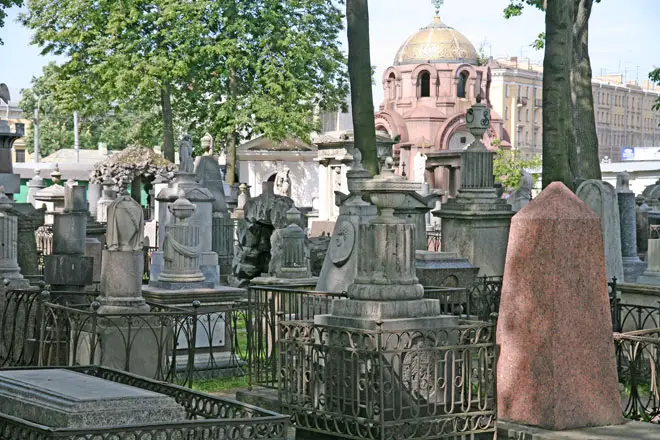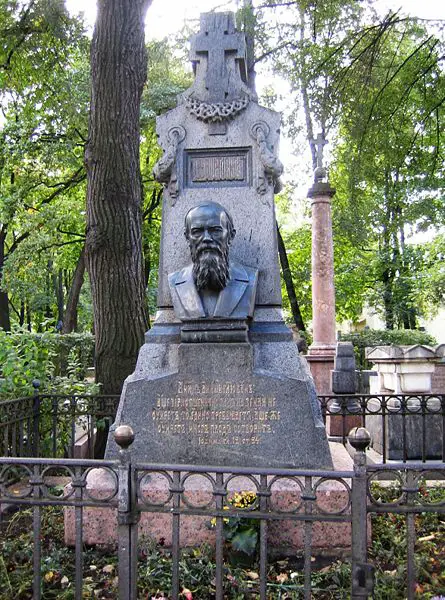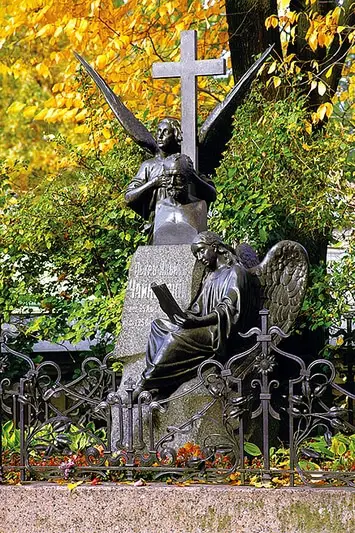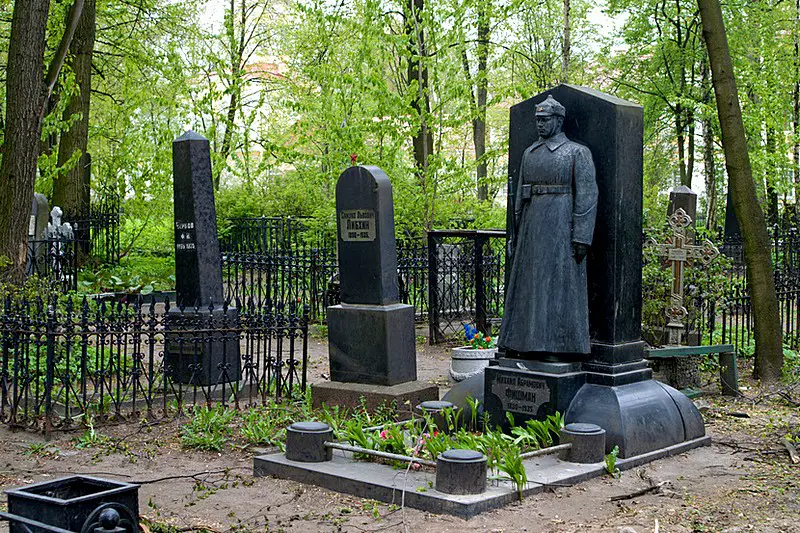St. Petersburg abounds in museums, historic sites, and places that appear in Russian literature. At the Alexander Nevsky Monastery, there is one more unique way to experience history – by visiting the final resting place of some of the city’s greatest names.
Located next to the monastery are four cemeteries – Lezarevskoe, Tikhvinskoe, Nikolskoe, and Kazachoe (Cossack). Tikhvinskoe is the most famous, known as the “Necropolis of Artists.” Here lie the remains of many prominent St Petersburg authors and composers including Nikolai Karamzin, Fyodor Dostoyevsky, and Pyotr Tchaikovsky. You’ll also find the writer Ivan Krylov, poets Vasily Zhukovsky and Nikolai Gnedich, artists Ivan Kramskoy and Boris Kustodiev, as well as composers Modest Mussorgsky and Alexander Borodin. Further, each gravestone stands as a work of art in their own right as they pay tribute to each great leader of Russian culture.

Despite its historical importance, many graves fell to disrepair in Russia’s tumultuous early twentieth century. In 1932, the State Museum of Urban Sculpture was founded inside the then-nationalized lavra (a type of monastery that allows seclusion for individual monks), located across the street from the cemetery. At the time, it was the only museum in Russia that engaged in the study, protection, and restoration of monuments of art in open urban environments. One of the museum’s tasks was to restore the graveyard as well as other city monuments, gravesites, and public spaces.
Today, the museum continues to do an excellent job of maintaining the memorials and landscaping. It also maintains the Narva and Moscow Triumphal Gates, the Sphinxes near the pier of the Academy of Arts, the Horse Groups on the Anichkov bridge, the monuments to Peter I, Catherine II, Nikolai I, A.S. Pushkin, M.V. Lomonosov, and A.V. Suvorov. Over the years these statues have become symbols of St Petersburg and their maintenance is vital to the city’s cultural history. The museum also holds a collection of sculptures and graphics with various exhibitions on contemporary art.
The graveyard supplies maps to visitors for the most significant grave sites. However, the gated area is a quiet place in a busy Russian city, where one can reflect on their own lives while also paying respect to famous Russian authors. Thus, it lends itself much more to quiet strolling than goal-oriented map following. The cemetery allows the visitor to become lost in their own thoughts as they explore memorials of people who lived before them.

Although the cemetery is maintained by the museum, it still functions as one would expect a cemetery to function. Aside from the maps available, there is no additional information posted as you walk through. Therefore, researching the history before visiting can be helpful.
The oldest graves are in the Lazarevskoe Cemetery, which was the first of the cemeteries to be founded. These date back to as early as the 1700s, when the city was first founded. Here you can find marble tombstones marking the remains of Peter I’s relatives, including the remains of Ivan V’s wife, Tsaritsa Praskovia Fyodorovna, and Peter’s granddaughter, Natalia.
In the latter half of the eighteenth century, the elaborately sculpted graves that the cemetery became known for began to appear. In 1823, the Tikhvinskoe Cemetery was established next to the Lazarevskoe Cemetery, as a means to avoid overcrowding. This roughly coincided with the beginning of Russia’s Golden Age of culture. Many of those who contributed to that Golden Age are now buried here, under stones created by some of the greatest sculptors of the time: Peter von Klodt, Nicholay Lancer, Alexei Shchusev, and Nikolay Roerich.

The focal point of Dostoyevsky’s grave in Tikhvinskoe, for example, is a stoic bust of Dostoyevsky completed in 1881. Above this is a cross and a crown of thorns which symbolizes his devotion to the Orthodox Church and Christianity in general. Furthermore, engraved on the statue is the following inscription: “truly, truly, I tell you, unless a kernel of wheat falls to the ground and dies, it remains only a seed; but if it dies, it bears much fruit (John 12:24).” This quote is not only a reference to Dostoyevsky’s deeply held religious beliefs but also acknowledges that his literary accomplishments continue to flourish even after his death.
Similarly, Tchaikovsky’s grave in this “Necropolis of Artists” is similarly embellished with Tchaikovsky’s bust placed between two angels. The first angel is reading the Bible and the other holds a cross as she looks up towards heaven. By associating Tchaikovsky with angels – something eternal – the statue symbolizes the continuance of his music even after his death. The angels are also graceful, like so much of his powerful music. The effect is somber, but also uplifting, as the viewer is aware that his legacy will far exceed his time on earth.

There are also examples of simple and yet still breathtaking memorials. For example, Karamzin’s grave attracts attention because it is an above ground casket plainly crafted out of white marble. The only decoration is a darker colored wreath carved on the center of the tomb. He is interred next to his wife, Ekaterina, who has an identical casket. Ivan Krylov’s grave is also simple: a rectangular gravestone rather than a statue or tomb. Although they are not as lavishly decorated as some of the other memorials they are just as eye-catching, stopping the viewer in their tracks to admire the grave markers’ simplicity.
vThe above ground casket of Karamzin and his wifeIn 1863, the Nikolskoe Cemetery was founded. In this part of the cemetery there are various chapels that were used for burials. These are built in the Russian Revivalist style, which is sharply juxtaposed with the tombstones, which are more modern and/or decorated with majolica and mosaics. In the twentieth century, numerous famous individuals were buried in Nikolskoe: the first Russian aviators Sergei Utochkin and Leo Matsievich, as well as historian Lev Gumilev and St Peterburg’s first post-communist mayor, Anatoly Sobchak.
In 1917 the smallest cemetery, known as the Kazachoe (Cossack) was renamed the Communist Cemetery. During the Soviet period, this is where Cossacks, Bolsheviks, and Civil War heroes were buried. Today, this small cemetery is known again by its original name. Prominently, in this section, stands an elaborate gravestone for a Red Army solider named Михаил Абрамович Фишмана, who lived from 1890 to 1935. In front of the stone is a full statue of a stoic soldier holding his gun. The statue acknowledges the deceased continued commitment to his country even after his death.

The Alexander Nevsky Lavra Cemetery is a silent place in an otherwise noisy city that provides solace for those who wish to pray, relax, or explore. However, the statues, gravestones, and monuments also loudly tell the stories of those they are paying tribute to. Thus, walking through the rows of gravestones provides a unique experience for those interested in St Petersburg’s cultural and political history.
Alexander Nevsky Lavra Cemetery
Ploshchad’ Aleksandra Nevskogo
Hours: 9 am – 8 pm daily except Saturday, 9 am – 9 pm.
Admission: foreigners – 150 RUB and 50 RUB for preferential categories




